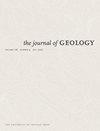Early Jurassic Mafic Magmatism in the Eastern Tethyan Himalaya, Southern Tibet
IF 1.3
4区 地球科学
Q2 GEOLOGY
引用次数: 1
Abstract
An Early Jurassic (∼196 Ma, laser ablation multiple-collector ICP-MS zircon U-Pb ages) suite of diabase dikes and sills has been identified within the Late Triassic Langjiexue Group, part of the Tethyan sedimentary sequence that is composed of shale and fine-grained sandstone. More primitive rocks (MgO>8.0 wt%) from this suite are characterized by mid-ocean ridge basalt–like rare earth element distribution patterns and isotope (Sr and Nd) compositions, as well as relatively high contents of mantle-compatible elements (e.g., Cr, Ni, and Co), which indicates that they were derived from partial melting of depleted mantle. Younger (∼140 Ma) mafic magmatism in the region has been proposed to represent the initial breakup of the eastern Gondwana continent and the opening of the Indian Ocean. We propose that the ∼196 Ma diabases developed in a continental extension setting and represent the products of melting of depleted mantle within or on the margin of the Neo-Tethyan Ocean.藏南特提斯喜马拉雅东部早侏罗世基性岩浆作用
在晚三叠世琅界雪群(特提斯沉积序列的一部分,由页岩和细粒砂岩组成)中发现了一套早侏罗世(~ 196 Ma,激光烧蚀多集电极ICP-MS锆石U-Pb年龄)辉绿岩岩脉和岩床。本组原始岩石(MgO>8.0 wt%)的稀土元素分布模式和同位素(Sr、Nd)组成具有洋中脊玄武岩样特征,且地幔相容元素(Cr、Ni、Co)含量较高,表明其来源于贫地幔的部分熔融。该地区更年轻(~ 140 Ma)的基性岩浆活动被认为代表了东冈瓦纳大陆的初始分裂和印度洋的开放。我们认为~ 196 Ma辉绿岩是在大陆伸展环境中发育的,是新特提斯洋内部或边缘的枯竭地幔熔融的产物。
本文章由计算机程序翻译,如有差异,请以英文原文为准。
求助全文
约1分钟内获得全文
求助全文
来源期刊

Journal of Geology
地学-地质学
CiteScore
3.50
自引率
5.60%
发文量
0
审稿时长
3 months
期刊介绍:
One of the oldest journals in geology, The Journal of Geology has since 1893 promoted the systematic philosophical and fundamental study of geology.
The Journal publishes original research across a broad range of subfields in geology, including geophysics, geochemistry, sedimentology, geomorphology, petrology, plate tectonics, volcanology, structural geology, mineralogy, and planetary sciences. Many of its articles have wide appeal for geologists, present research of topical relevance, and offer new geological insights through the application of innovative approaches and methods.
 求助内容:
求助内容: 应助结果提醒方式:
应助结果提醒方式:


